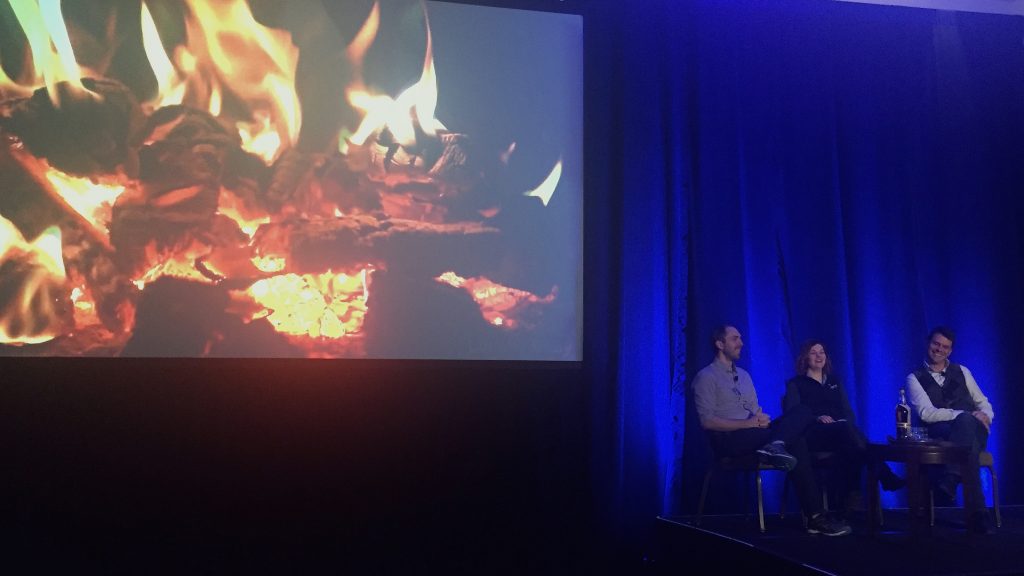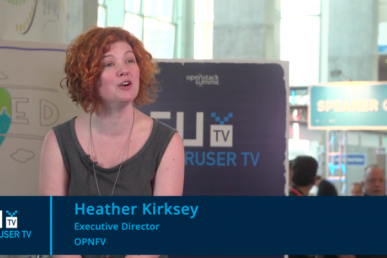Heather Kirksey likes to call them as she sees them.
As director for Open Platform for NFV (OPNFV) — a role she alternatively describes as coach, nerd matchmaker and diplomat — she oversees and provides guidance for all aspects of the project, from technology to community and marketing. At the recent Linux Foundation Open Source Leadership Summit, she headed up a session titled “Open Source as a Team Sport” with and OPNFV’s Chris Price and OpenStack’s Jonathan Bryce.
Kirksey put some thought into the proceedings — setting up a crackling fire video on a giant screen and producing a bottle of whiskey to facilitate a “fireside chat.” She kicked off the session with clips from one of her favorite movies, “Miracle.” Based on the true story of a player-turned-coach who brought the 1980 U.S. Olympic hockey team to victory over Russia, early scenes in the movie show how even successful team building can sometimes be a, well, contact sport.
Superuser sat down with Kirksey – in a busy hallway, minus the whiskey – to ask her more about the parallels between hockey and open source. She tells us why the brutality of hockey is a good metaphor for open source, about leveling the open source playing field for women and how you can get involved with OPNFV.
Of all the team sports, hockey is one of the most violent, right?
Why do you think I like hockey? I like my sports with a side of brutality…In most sports there are tensions that flare up and sometimes it can get raw and there are fisticuffs. At the end of the day, you need to come together because you’re trying to accomplish a goal.
In the first clip I showed, the part where the coach starts talking about how to come together after the two guys started fighting. And he was like, ‘hockey is about flow and creativity’ that’s really where you want to get to when you’re creating something new and innovating, like we are in open-source communities. And remembering that aspect of it — the joy of making that and creating a space where you can find joy and have fun as a community is really important.
So there’s still a Kumbaya at the end, but you may have to punch somebody in the face to get there.
Yes. It’s like après-ski — after you’ve like fallen down a mountain for a couple days, that hot tub and whiskey feel awfully nice.
Kirksey leads a “fireside chat” with Jonathan Bryce and Chris Price.
Do you see your role as coach, like the Kurt Russell character in the movie?
He [Herb Brooks] was one of the legendary coaches of hockey, so it’d be a little self-aggrandizing to make that comparison. But I do feel a large part of my role is to facilitate community, to remind people to have empathy…Sometimes it’s reminding people that we are on the same team and we are trying to solve the same problems.
How does your approach change on a mailing list or IRC versus in-person?
The in-person interaction can be more focused on relationship building and helping people get to know each other. Sometimes if the conflict is really getting intense, there’s no substitute for face-to-face or on-phone real-time interactions to talk through things.
Back when I chaired standards committee, we would have all these disagreements and contributions. And sometimes people would be arguing different aspects and talking past each other. So I developed a framework, for example, if someone was proposing a solution to a problem. First, do we agree that there is a problem? And do we agree that *this* is the problem? All right, now do we agree on how to solve the problem? Or, are we arguing details of the approach or are we arguing the entire approach itself? You learn to go through it in a structured way…
Earlier, you mentioned your other role as the “United Nations Secretary” between the OPNFV community and other communities. What’s your diplomatic strategy?
You have to learn where the understanding point is for the other community, which involves getting to know them. And then do some education. A lot of people don’t know how networks are deployed currently, nor what they’re trying to transform to. So giving a little bit of 101 — you have a core and an access piece and the places where mobile and fixed line come together and we’re trying to address these issues with those aspects. Or come up with analogies. I’m a big fan of analogies.
One of the things that I try to do a lot of at events, especially outside ones, is try to come up with activities at the event, or parties and things to facilitate people interacting. And trying to broker introductions: ‘You’re working on performance testing in this community. And you’re working on performance testing in this community. Hey, why not talk — I’ll buy you a beer.’ I pick up a lot of beer tabs for developers. I’m kind of a professional beer-tab picker-upper.
Do you also see yourself as a matchmaker?
Yeah. A little bit sometimes, a matchmaker of nerds. But if you can find that common ground — say both people are doing the same thing but in different communities, then they immediately have a starting point. And generally people are excited to talk about what they’re working on.
Congratulations on the nomination for the Women in Open Source Award. How long do you think it’ll be before it’s *not* about women in open source— just people who are outstanding, period?
Well, I have been in the tech industry for 19 years now and the percentage of women hasn’t really gone up. Although I think we’re having better conversations about it now. We’re having more allies-oriented conversations, which I think are good.
I think a lot of folks — anywhere on the gender spectrum — are realizing this shit has got to change…For example, folks are now measuring diversity — you’re not going to change what you don’t measure. The fact that a lot of tech companies are now measuring their diversity and setting diversity goals matters. And the fact that the Linux Foundation worked with National Center for Women & Information Technology (NCWIT) to create training for speakers and conferences matters. We’re seeing more structure around it now, for sure.
What else might make a difference?
Root out the structural inequalities of our modern world? [laughs.] That’s obviously is a bigger thing… The issues in tech reflect broader societal issues… Unconscious bias, for example, being one of the big things… Part of it is human, we get used to the way things are and change is difficult. We get used to people who are like us and share common background experiences or common cultural references, even. And so unconscious bias is a really hard thing to root out. Accepting that it exists and being aware of it and trying to catch yourself and being intentionally thoughtful and self-reflective in your hiring decisions, in your community processes and on your conference panels helps.
Get Involved with OPNFV
Whether you’re an employee of a member company or just passionate about network transformation, you’ll find the basics of how to get started (creating an account, mailing lists, Wiki, projects) here.
To meet OPNFVers in person (and maybe get some free beer?) you’ll find them at the upcoming Open Networking Summit, OpenStack Summit and the OPNFV Summit.
For Open Stack individual contributors, what’s a good starting point at OPNFV?
If you’ve got any CI/CD knowledge, that would be great. Also our testing projects are a good place to start, because really what we focus on as a community is NFV stat testing which spans a lot of different pieces from a lot of different communities. We never have enough tests or people writing test cases. That’s a need and a lower barrier to entry, scripting a test case versus diving into changing a networking part of Neutron, for example. And then you get a lot more exposure to the software itself, how it’s configured, how it’s run, how it deploys, what it’s supposed to do and what success is and what failure is.
You can also reach out to the individual Project Team Leads (PTLs)…They’re great and they love to hear from people who want to contribute to the project.
Cover photo by: Martyn Hayes
- OpenStack Homebrew Club: Meet the sausage cloud - July 31, 2019
- Building a virtuous circle with open infrastructure: Inclusive, global, adaptable - July 30, 2019
- Using Istio’s Mixer for network request caching: What’s next - July 22, 2019

)











